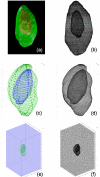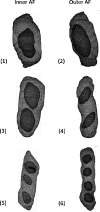Pericellular Matrix Mechanics in the Anulus Fibrosus Predicted by a Three-Dimensional Finite Element Model and In Situ Morphology
- PMID: 19946619
- PMCID: PMC2782835
- DOI: 10.1007/s12195-009-0081-7
Pericellular Matrix Mechanics in the Anulus Fibrosus Predicted by a Three-Dimensional Finite Element Model and In Situ Morphology
Abstract
Anulus fibrosus (AF) cells have been demonstrated to exhibit dramatic differences in morphology and biologic responses to different types of mechanical stimuli. AF cells may reside as single cell, paired or multiple cells in a contiguous pericellular matrix (PCM), whose structure and properties are expected to have a significant influence on the mechanical stimuli that these cells may experience during physiologic loading of the spine, as well as in tissue degeneration and regeneration. In this study, a computational model was developed to predict the micromechanical stimuli, such as stress and strain, fluid pressure and flow, of cells and their surrounding PCM in the AF tissue using three-dimensional (3D) finite element models based on in situ morphology. 3D solid geometries of cell-PCM regions were registered from serial confocal images obtained from mature rat AF tissues by custom codes. Distinct cell-matrix units were modeled with a custom 3D biphasic finite element code (COMSOL Multiphysics), and simulated to experience uni-axial tensile strain along the local collagen fiber direction. AF cells were predicted to experience higher volumetric strain with a strain amplification ratio (relative to that in the extracellular matrix) of ~ 3.1 - 3.8 at equilibrium, as compared to the PCM domains (1.3 - 1.9). The strain concentrations were generally found at the cell/PCM interface and stress concentration at the PCM/ECM interface. Increased numbers of cells within a contiguous PCM was associated with an apparent increase of strain levels and decreased rate of fluid pressurization in the cell, with magnitudes dependent on the cell size, shape and relative position inside the PCM. These studies provide spatio-temporal information on micromechanics of AF cells in understanding the mechanotransduction in the intervertebral disc.
Figures









References
-
- Acaroglu ER, Iatridis JC, Setton LA, et al. Degeneration and aging affect the tensile behavior of human lumbar anulus fibrosus. Spine. 1995;20(24):2690–2701. - PubMed
-
- Alexopoulos LG, Haider MA, Vail TP, et al. Alterations in the mechanical properties of the human chondrocyte pericellular matrix with osteoarthritis. Journal of Biomechanical Engineering. 2003;125(3):323–333. - PubMed
-
- Alexopoulos LG, Setton LA, Guilak F. The biomechanical role of the chondrocyte pericellular matrix in articular cartilage. Acta Biomater. 2005;1(3):317–325. - PubMed
-
- Alexopoulos LG, Williams GM, Upton ML, et al. Osteoarthritic changes in the biphasic mechanical properties of the chondrocyte pericellular matrix in articular cartilage. Journal of Biomechanics. 2005;38(3):509–517. - PubMed
-
- Almeida ES, Spilker RL. Finite element formulations for hyperelastic transversely isotropic biphasic soft tissues. Computer Methods in Applied Mechanics and Engineering. 1998;151(3–4):513–538.
Grants and funding
LinkOut - more resources
Full Text Sources

